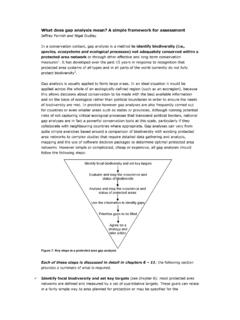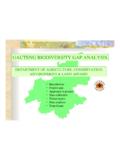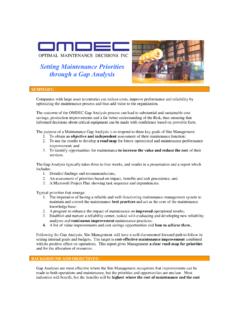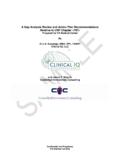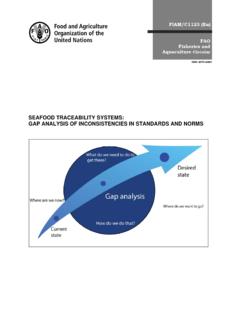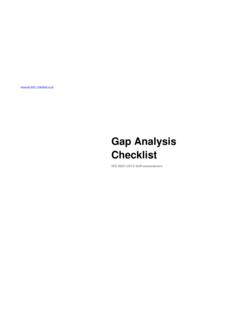Transcription of A MODEL FOR COMPETENCE GAP ANALYSIS - L3S
1 A MODEL FOR COMPETENCE GAP ANALYSIS Juri L. De Coi, Eelco Herder, Arne Koesling, Christoph Lofi,Daniel Olmedilla, Odysseas Papapetrou, and Wolf SiberskiL3S Research Center and University of Hannover, Hannover, competency, MODEL , gap analisys, lifelong learningAbstract:Modeling competences is an integral part of many Human Resource (HR) and e-Learning related departments use COMPETENCE descriptions to define requirements needed for performing specific tasks orjobs. The same competences are acquired by employees and applicants by experience or , HR departments need to match such required and acquired competences in order to find suitablecandidates. In e-Learning a similar situation arises. Curricula or training programmes need to describe pre-requisites that must be fulfilled before joining and the competences that will be acquired after successfulcompletion.
2 This paper analyses the limitations and extends existing approaches for modeling competences inorder to allow (semi-)automatic COMPETENCE IntroductionNowadays, people mobility has increased. Learnersmay study abroad with the benefits of improving theirlanguage skills, receiving a better certification, or spe-cializing in a topic not available in their regions. Thesame applies to the labour market. People do not needto restrict themselves to their city or region while seek-ing for a job but may consider offers in other countries,too. This situation complicates the already difficult jobof managers in learning organizations and Human Re-source (HR) departments to decide who may have theright qualifications to join a project or the company it-self. For learning organizations, requirements to jointhe programme must be taken into account.
3 For exam-ple, an applicant needs to possess a Bachelor degreeto apply for Master studies; in order to attend an expertcourse on a topic, a certification on a basic level may berequired. Furthermore, assuming that an applicant ful-fills such requirements, exemptions could be grantedfor parts of the programme that are similar to earlierfollowed courses. Imagine a Mathematician starting aComputer Science degree. Most likely, courses like Al-gebra and Statistics could be exempted. In the case ofHuman Resource departments, the task is equally com-plex. HR experts need to match applicant or employeeexperience and knowledge with the requirements of ajob offer or a project, including both mandatory re-quirements and desired ones ( , Business English isrequired and French would be a plus). Currently, allthese COMPETENCE matches have to be performed man-ually, with hardly any guidelines or support.
4 One im-portant reason for this is that there are currently nosufficiently expressive common formats for the repre-sentation of competences, which is needed for com- ThisresearchwaspartlyfundedbytheEUTENC ompetenceproject(FP6-IST-02787)( ) and EU PROLIX project(FP6-IST-027905) ( ).plex COMPETENCE profiles and requirements. Some ini-tiatives, such as the IEEE Reusable Competency Def-inition (IEEE RCD, 2005) and HR-XML (HR-XML,2004), have done initial steps to define common modelsand schemas for interoperability, but their current worklacks some important information that is required forcompetence matching, like proficiency levels, context(cf. Section 3) or mechanisms for increasing reusabil-ity. In this paper, we enhance and extend the work de-veloped under various initiatives and introduce a modelfor representing competences with their relationshipsas well as usage profiles (such as profiles for job re-quirements description or for learner achievements de-scription).
5 This MODEL provides the basis for allowingadvanced (semi-)automatic COMPETENCE matching andgap paper is organized as follows: section 2 clarifiesthe terms used throughout the paper and briefly in-troduces our requirements for modeling 3 provides an overview of existing modelingspecifications, and section 4 describes our modelingapproach for competences in a more detailed 5 introduces COMPETENCE profiles (collectionsof competences) which represent the most visible as-pect of COMPETENCE modeling in real-life 6 gives an example on how a simple profile andrelated competences can be modeled. Finally, section 7concludes this paper with a summary and an outlookon future What is a COMPETENCE ?In this work we adopt the definition ofcompetenceas effective performance within a domain/context atdifferent levels of proficiency , as given in (Cheetamand Chivers, 2005).
6 Note that there exists some confu-sion on the termcompetency2in the literature. (IEEERCD, 2005; IMS RDCEO, 2002) define the stricterterm of competency as any form of knowledge, skill,attitude, ability, or learning objective that can be de-scribed in a context of learning, education or training .This definition is insufficiently expressive for compe-tence gap ANALYSIS . For example, it is not clear if pi-loting covers both the ability to pilot a small plane andto pilot a big passenger airplane. Or if the competency English writing skills represents a specific level suchas intermediate, fluent, native or simply the existenceof the competency. In fact, if that information becomespart of the competency definition, its reusability is dras-tically reduced (with the consequence of, , hav-ing different competency definitions for each contextin which a competency is applied, and for any profi-ciency level and proficiency level scale).
7 The definitiongiven in (HR-XML, 2004) tries to extend the previousone: A specific, identifiable, definable, and measur-able knowledge, skill, ability and/or other deployment-related characteristic ( , attitude, behavior, physi-cal ability) which a human resource may possess andwhich is necessary for, or material to, the performanceof an activity within a specific business context . Inthis case, measurable indicates a relationship with aspecific proficiency level3and competency now appliesonly to the business context. In any case, since contextis implicit, the models proposed from these specifica-tions do not include context stated above, current approaches to modelingcompetencies do not explicitely address proficiencylevel and context. On the contrary, we believe that com-petency, proficiency level and context are three differ-ent dimensions that should be modeled separately inorder to maximize their reuse.
8 For example, the samecompetencies may be used in different contexts, or thesame proficiency level scales may be reused amongdifferent certifications. The same applies to contexts(or domain models ), which in many situations al-ready exist and therefore may be reused by compe-tences. Therefore, according to what stated above,we MODEL COMPETENCE (plural:competences) as a three-dimensional variable, made up of a competency (plu-ral:competencies), a proficiency level and a context(see figure 1). For example, Fluent Business English would be composed of the competency English , theproficiency level Fluent and the context Business .For sake of clarity, and in order to avoid confusionbetween the terms COMPETENCE and competency, wemay use competency and skill interchangeably here-after.
9 However the reader should be aware that skillis not a synonym for competency, as it only covers partof its reader is alerted for the distinction between the twoterms,competenceandcompetency3 Although they later refer to it as grade , which is differ-ent from proficiency level - see section 1: COMPETENCE as a combination of competency, pro-ficiency level and context3 Related WorkThere exist some standardization efforts on mod-elling competencies. These efforts focus on differentaspects related to competency: competencies as such,competency profiles and relationships among IMS Reusable Definition of Competencies orEducational Objective (IMS RDCEO, 2002) and thelater IEEE Reusable Competency Definition (IEEERCD, 2005) (based on IMS RDCEO) focus on reusablecompetency definitions. The primary idea is to buildcentral repositories which define competencies for cer-tain communities.
10 These definitions can be referencedby external data structures, encouraging interoperabil-ity and reusability. However, IEEE RCD lacks infor-mation on context and proficiency level and does notallow relationships or recursive dependencies focuses on the modeling of a wide rangeof information related to human resource tasks (likecontact data or aspects of the curriculum vitae). Thework performed in HR-XML Measurable Competen-cies (HR-XML, 2004) tries to define profiles in order touse such competency definitions. It specifies data setslike job requirement profiles (which describe the com-petencies that a person is required to have) or personalcompetency profiles (which describe the competenciesa person has). Such profiles are composed of evidences(either required or acquired) referring to competencydefinitions ( , IEEE RCD).
